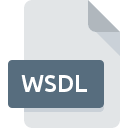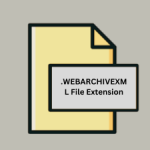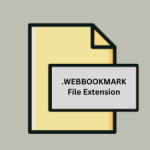.WSDL File Extension

What is an WSDL file?
A .WSDL file is a document written in XML that defines a web service. It describes the web service’s functionality, including the operations it performs, the messages it can send and receive, and the protocols it uses. This file format is used to enable communication between different web services and applications.
More Information.
WSDL was created to facilitate the discovery and interaction with web services over the Internet. It provides a machine-readable description of a web service’s capabilities, making it easier for clients to understand how to interact with the service. The goal was to simplify the integration of web services by providing a common format for describing service interfaces.
Origin Of This File.
The Web Services Description Language (WSDL) was developed by the World Wide Web Consortium (W3C) and first introduced in 2001. It was designed as part of the web services architecture to standardize the description of web services and enable interoperability between different systems.
File Structure Technical Specification.
- Types: Defines the data types used by the web service, often using XML Schema.
- Message: Describes the messages exchanged between the client and the service.
- PortType: Specifies the operations provided by the web service, including the input and output messages for each operation.
- Binding: Defines the protocols and data formats used for communication (e.g., SOAP, HTTP).
- Service: Provides the address (URL) where the web service can be accessed.
How to Convert the File?
Windows
On Windows, WSDL files are generally not converted into other formats directly.
Instead, you can use tools and libraries to generate code or documentation from a WSDL file. For instance:
- Using Visual Studio: Visual Studio can generate client code from a WSDL file, allowing you to interact with the web service in a .NET environment.
- Using SOAP UI: SOAP UI can import WSDL files to create test suites and execute requests to the described web services.
Linux
On Linux, conversion of WSDL files typically involves generating client code or documentation. You can use tools like:
- Apache CXF: A command-line tool that can generate client-side code from a WSDL file for integration into your Java projects.
- WSDL2Java: Part of Apache Axis2, this tool also generates code from WSDL files.
macOS
On macOS, you can convert WSDL files by generating code or documentation using:
- Xcode: Although not as commonly used for WSDL files, you can utilize tools like
wsimportto generate code from WSDL files. - Command-line tools: Similar to Linux, tools like Apache CXF or WSDL2Java can be used to convert WSDL files into usable code.
Android
On Android, conversion of WSDL files is usually handled by:
- Libraries: Use libraries like KSoap2 that can consume WSDL files and allow interaction with web services in Android apps. This involves including the library in your project and configuring it to use the WSDL file.
- Online Tools: Online services can convert WSDL files to code or documentation, which can then be integrated into Android projects.
iOS
For iOS, WSDL files are typically handled by:
- Libraries: Use libraries such as SOAPEngine that can work with WSDL files to create iOS-compatible client code.
- Online Tools: Similar to Android, online tools can convert WSDL files into formats that can be utilized in iOS development.
Others
In other environments:
- Online Converters: Various online tools can convert WSDL files to different formats or generate code in various programming languages.
- IDE Plugins: Some integrated development environments (IDEs) have plugins or extensions that can import WSDL files and generate code or documentation.
Advantages And Disadvantages.
Advantages:
- Standardized Format: Provides a standardized way to describe web services, which aids in interoperability.
- Machine-Readable: Can be processed automatically by tools and applications, facilitating integration.
- Supports Multiple Protocols: Can describe services that use different communication protocols (e.g., SOAP, HTTP).
Disadvantages:
- Complexity: WSDL can be complex and verbose, making it challenging to read and maintain manually.
- Limited to XML: Primarily XML-based, which may not be ideal for all environments or technologies.
- Overhead: Can introduce additional overhead in terms of performance due to its verbosity.
How to Open WSDL?
Open In Windows
- Visual Studio: Can open and edit WSDL files.
- Notepad++: A text editor that can handle XML-based files like WSDL.
Open In Linux
- Command Line Tools: Tools like
curlorwgetcan fetch WSDL files. - Text Editors: Editors such as Vim or Gedit can be used to view or edit WSDL files.
Open In MAC
- TextEdit: Can open and edit WSDL files.
- Xcode: Can work with XML files, including WSDL.
Open In Android
- Web Browser: Android devices can view WSDL files through a browser.
- Text Editors: Apps like QuickEdit or AIDE can edit XML files including WSDL.
Open In IOS
- Files App: iOS devices can view WSDL files through the Files app or compatible apps.
- Text Editors: Apps such as Textastic or Koder can edit XML files, including WSDL.
Open in Others
- Online Editors: Websites like CodePen or online XML editors can open and edit WSDL files.
- Integrated Development Environments (IDEs): Many IDEs support XML and WSDL files, including Eclipse and IntelliJ IDEA.













